Update: The ATF Reverses Course, Again
Last week, Q LLC, manufacturer of the boutique Honey Badger AR pistol, made public an Aug. 3 cease-and-desist letter from the Bureau of Alcohol, Tobacco, Firearms and Explosives that seemed to outlaw thousands of Honey Badger pistols — exposing owners to potential felony charges. A few days later, on Oct. 9, the Justice Department stepped in and published its own letter, suspending the ATF order for 60 days and effectively punting along further action until after the Nov. 3 presidential election.
News of the ATF letter to Q has sent shock waves through the Second Amendment community. Do the ATF’s concerns apply to all AR pistols — a wildly popular category of firearms that exploded on the scene only a few years ago? Is the agency’s decision politically motivated, a seismic shift in gun policy, timed squarely at the November election? Is this a one-off ruling, only applicable to Q LLC? What does it mean for the future of America’s new favorite truck gun?
Here’s what we know. Spoiler alert: Unless you own an actual $2,400 Honey Badger pistol from Q, you’re probably okay — at least for now.
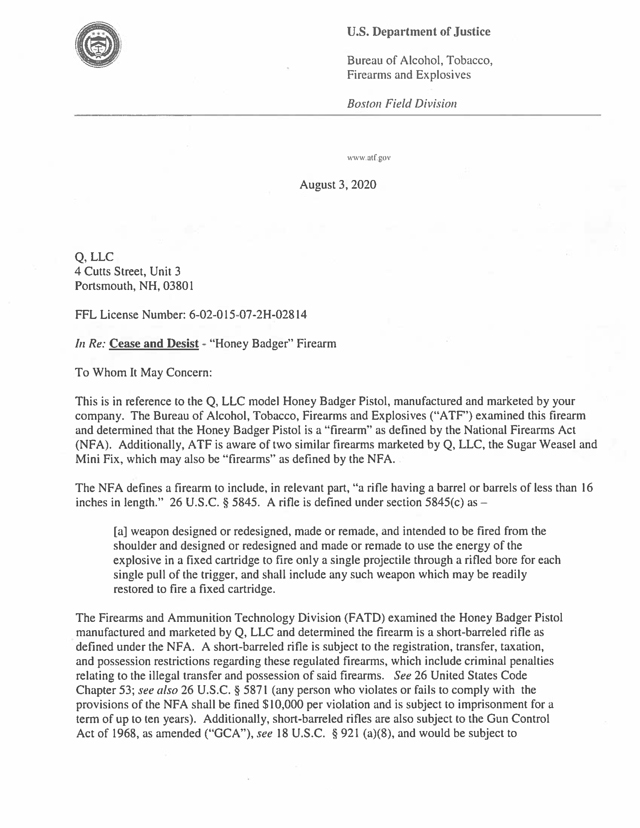
Buttstock vs. Brace
The ATF considers three common firearm characteristics to classify a pistol.
First, the overall length of the gun must be 26 inches or less. Second, the barrel cannot be longer than 16 inches. Third, the firearm cannot be designed to be fired from the shoulder. The presence of a buttstock and vertical foregrips is a big no-no for a firearm classified as a pistol.
In 2014, the ATF issued a determination that allowed manufacturers to sell pistols with an arm brace substituted for a buttstock. From a distance, it can be difficult to differentiate between buttstocks and braces. They perform similar functions — to help shooters manage recoil. The difference is in how they accomplish this function. Buttstocks are generally larger than braces and are composed of a rigid material so the gun can be fired from the shoulder. As with any rifle, the buttstock is seated in the shoulder pocket of the shooter while firing. While buttstocks come in a variety of styles, they are usually rectangular or triangular in shape — made from a solid piece of wood, metal, or a strong polymer material.
Braces provide similar support and improve stability while shooting, however, not primarily from the shoulder. The material they’re made from, usually flexible plastic or hard rubber, is designed to rest against the wrist or wrap around the forearm with a strap for one-handed shooting. Braces come in countless styles, from simple, padded buffer tubes on AR pistols to models that more closely resemble the shape of buttstocks. Manufacturers have pushed the boundaries — some braces can be used to effectively fire from the shoulder, but the maker must demonstrate that those are designed to be stabilized in other ways.
SB Tactical formally debuted the first pistol arm brace at the 2015 Shooting, Hunting, Outdoor Trade (SHOT) Show. About this same time, the ATF issued an open letter to the public that appeared to contradict its original position on pistol braces. The letter reiterated that an AR pistol was not a more heavily regulated short-barreled rifle, or SBR, but said if the end user ever shouldered a braced AR, it could be considered an SBR. Confused? So was everyone else at the time.
SB Tactical and SIG Sauer, which had exclusive marketing rights to the original SB Tactical brace, challenged these findings and spent the next two years working with the ATF to defend the brace’s design. In 2017, the ATF replied to SB Tactical in writing and essentially admitted its previous interpretation was inaccurate. An AR with a brace is still a pistol, regardless of how it’s held.

Pistol vs. SBR
According to ATF guidelines, an AR-15 with a sub-16-inch barrel and an overall length less than 26 inches with a brace is considered a pistol. They can be bought and built, depending on state law, same as a Glock 19 or a 1911. Whether the brace is shoulder mounted like a buttstock by the shooter does not matter. It’s all legal.
If the brace is removed and replaced with a more traditional buttstock, it meets a new ATF classification and becomes a short-barreled rifle, or SBR.
SBRs are considered Class 2 (or Title II) weapons, regulated under the National Firearms Act (NFA). There are stark differences in the cost and buying process between an AR pistol and an SBR or any NFA firearm. Yes, there are several gucci AR pistols like the Honey Badger that run north of $2,000, but it’s also possible to find them (or build your own) for less than $500. Depending on state law, they can also be bought and paid for at a local gun shop and, after a background check, taken home that day.
Not so with an SBR. That buying process is the same as purchasing a suppressor or other Title II item. After paying the cost of the firearm and an additional $200 government tax, the buyer must complete ATF Form 4, a Tax Paid Transfer and Registration application, which is submitted to the ATF. The processing time for the paperwork can take three months to a year — and sometimes longer. Upon approval, the ATF sends a “tax stamp” to the dealer that allows the buyer to finally take the SBR home. Until that tax stamp is received, the firearm remains “on ice,” in the possession of the selling federal firearms licensed dealer.
As unreasonable and inconvenient as this process might seem, failure to follow it to the letter can have dire consequences, including weapon seizure by federal law enforcement, felony charges, and a rash of steep fines.

What’s Special About the Honey Badger?
If an AR is classified as an SBR, the cost and paperwork price becomes so steep that many gun rights advocates consider the process a violation of the Second Amendment. If an AR is classified as a pistol, it can ship to dealers for normal sale to the end user.
By all published ATF criteria, the Honey Badger from Q appears to meet the definition of an AR pistol.
Yet at the heart of the controversy is the Honey Badger’s proprietary stabilizing brace, also manufactured by SB Tactical. Today, SBT provides braces like the one included on the Honey Badger to nearly every AR pistol manufacturer in the firearms industry.
Q claims the ATF has arbitrarily singled out the Honey Badger — and has requested info on Q’s other pistol, the Sugar Weasel. According to the ATF’s letter, “the objective design features of the Honey Badger firearm, configured with the subject stabilizing brace, indicate the firearm is designed and intended to be fired from the shoulder. Since this firearm also contains a rifled barrel, it meets the definition of a ‘rifle.’ Further, since it has a barrel of less than 16 inches in length, this firearm also meets the definition of a ‘short-barreled rifle’ under the GCA and NFA.”
In a recent interview with attorney and gun rights activist Colion Noir, Q CEO Kevin Brittingham said the ATF has not made it clear why it chose to single out the Honey Badger. “There are 1.2 to 1.3 million SBA3 [braces] on the market,” he said. There are 4 million total arm braces, meaning this issue impacts a larger population than the controversy with the bump stock, which has an estimated 10,000 to 50,000 units in public hands. Brittingham’s fear is that without additional clarification from the ATF, this ruling could put owners of those 4 million or so AR pistols on the wrong side of the law.
The ATF’s technical evaluation of the Honey Badger also cites the length of pull for the firearm’s adjustable brace. This is the measured distance from the buttplate, or braceplate, to the trigger. Traditional rifles designed on the AR platform include a telescoping buttstock that allows the shooter to shorten or lengthen the weapon for comfort and tactical application, such as making it smaller for vehicle storage.
Many pistol braces provide the same adjustability. Per ATF guidelines, AR pistols equipped with braces may not have a length of pull longer than 13.5 inches — in other words, at full extension, the distance between the trigger and the rear edge of the brace cannot exceed 13.5 inches. The evaluation asserts that the Honey Badger’s length of pull exceeds 13.5 inches, but this has left many scratching their heads. Brittingham contends the ATF must have used a nonstandard method to obtain the measurement as, typically, the pistol at full extension measures 13.35 inches, well under the outer limit of 13.5.
SB Tactical has two approval letters from the ATF, one for its original brace introduced in 2015 and another for a newer MPX. No such letter exists for the proprietary Honey Badger brace, nor the SBA3 6-position brace used on the Q Sugar Weasel and countless other AR pistols.
However, there is no precedent for obtaining written approval for every brace, according to SB Tactical. The overall design of the SBT Honey Badger brace — commonly referred to as an “adjustable bifurcated flap with a strap” — was blessed by the ATF in 2017 when it was introduced on the SIG Sauer MPX. But the ATF has made it clear that accessories are not automatically approved for all firearms. Each one is judged as a new pistol design, placing the burden of compliance upon the gun manufacturer or the DIY builder. This approach has apparently allowed the ATF to single out individual models and manufacturers. Despite the similarities to the MPX brace, does Q’s proprietary model somehow compromise the Honey Badger’s pistol classification?
“Maybe that’s what they’re going after,” Brittingham told Noir. “But they refuse to answer questions.” If that’s the case, then the ramifications of this ATF decision could reach far beyond Q.

Is This Political Grandstanding?
The timing of this debate is curious, with an election around the corner and political parties scrambling to get the pro-gun and anti-gun electorate out to vote. But the battle between Q and the ATF has been going on since at least last summer. Q decided to publish the cease-and-desist letter last week, which is dated Aug. 3. Since then, the ATF has not responded to any of the company’s questions to seek clarification.
“They refuse to respond in writing,” Brittingham told Noir. “We didn’t publicize the letter at first because I thought we could work it out. [The ATF was] communicating with us initially. We said ‘Well, okay, tell us the things you want changed and we’ll change it and submit one so you guys can approve it. We won’t sell any until we get the approval.’”
As a small business, it wouldn’t make sense for Q to make an AR pistol with a length of pull longer than 13.5 inches or to not work with the ATF to resolve concerns. The market for AR pistols is so much larger than the niche world of SBRs that anything less would be bad for business. Brittingham has said he has no problem following the current rules, “but for [the ATF] to arbitrarily say our company can’t sell pistols but everyone else can — clearly that’s not right.”
Q has reached out to the National Rifle Association for assistance. The NRA attacked the ATF’s move as “arbitrary, inequitable, and incorrect,” and confirmed it has also been in touch with the US Department of Justice and Trump administration officials to review the situation. Amy Hunter, a spokeswoman for the NRA, told the Washington Free Beacon the group is “exhausting all options to overturn this unjust and rogue action by ATF.”
Alex Bosco, CEO of SB Tactical and inventor of the pistol stabilizing brace, has worked directly with the ATF to clarify the differences between buttstocks and arm braces. He’s equally perplexed by the Q cease-and-desist order. In a separate interview with Noir, Bosco pointed to Q’s good-faith attempt over the past few months to clarify and address the alleged issues with the Honey Badger. He also pointed to the optics surrounding the ATF’s apparent unwillingness to cooperate.
“I find it really odd,” he said, “that we’ve gotten to the point today where the [ATF goes] to Q, in this case — and we sell to just about every single OEM manufacturer in the market — they’ve gone to a small company and said, ‘Oh you’re doing that wrong.’ Q asked the ATF, ‘What do you want us to do?’ Do you know what the ATF said? ‘We can’t tell you what to do.’”
SB Tactical President Jeff Creamer told Free Range American that the entire industry and end-user community wants to follow the rules and operate within the law. “Unfortunately,” he said, “by refusing to publish clear standards, the ATF is making that very difficult to do.”
Since the Honey Badger story broke last week, the White House has weighed in as well. Deputy press secretary Brian Morgenstern said, “The White House and leadership at the Department of Justice are reviewing this matter to ensure there is no interference with the ability of law-abiding citizens — including lawful firearms manufacturers — to exercise their constitutionally guaranteed liberties.”
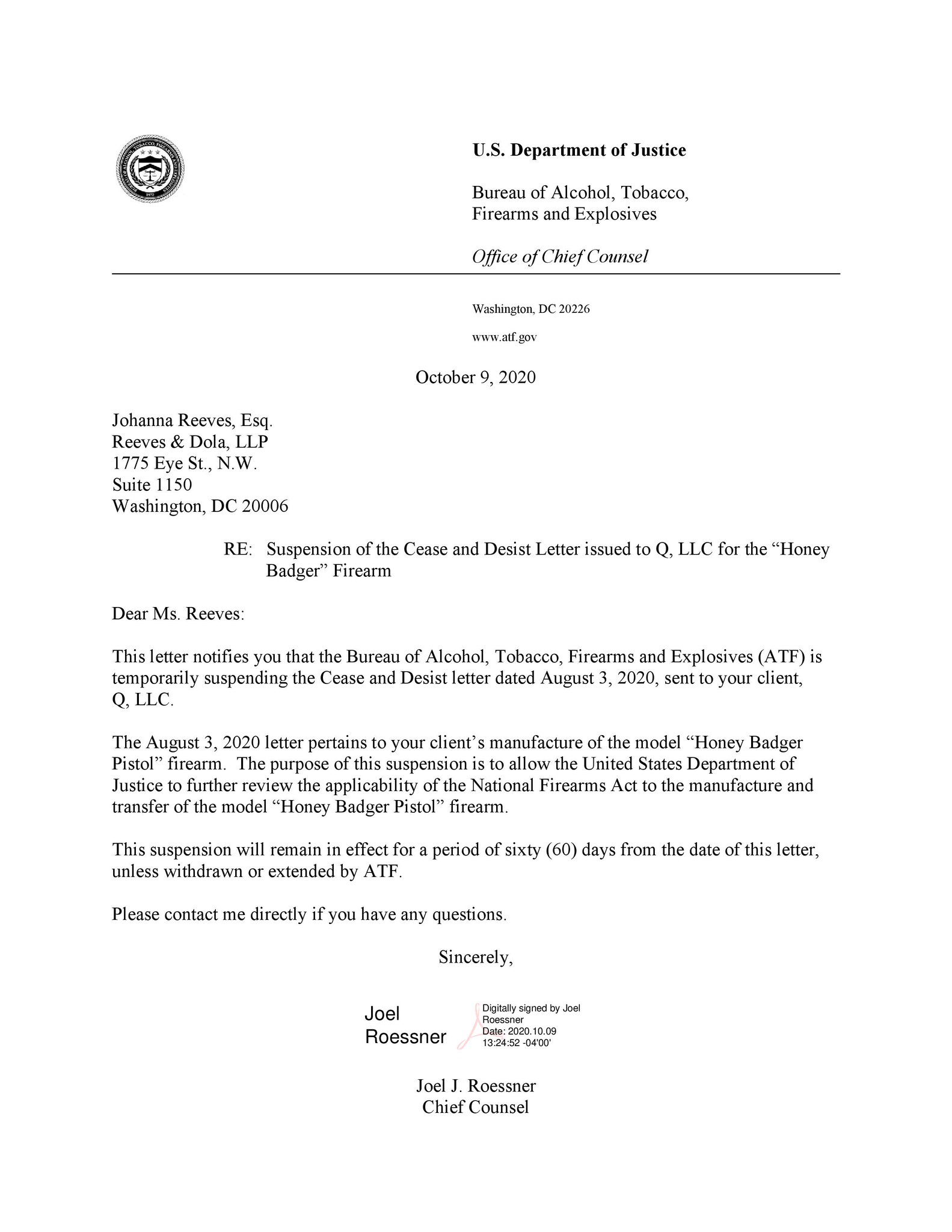
Is MY AR Pistol Illegal?
Many firearms industry insiders feel the Honey Badger reclassification attempt by the ATF is in direct conflict with the 2017 final ruling, as issued in a letter to SB Tactical.
On Oct. 9, the Washington Free Beacon reached the ATF for comment. Carolyn Gwathmey, public affairs officer with the agency, claimed the cease-and-desist letter to Q only applies to the Honey Badger pistol. However, she offered no further clarification on exactly how that firearm differs from others equipped with similar braces.
“Regarding other firearms or manufacturers,” she said, “ATF cannot comment until we see the platform and what accessories may be attached to said platform.” In other words, they reserve judgement.
The upshot of all this is that braces and AR pistols previously approved by the ATF continue to be legal until otherwise notified. While Honey Badger owners may be at legal risk, the recent intervention by the DOJ means no immediate action is required to remediate the firearm. We’ll know more in a few months.
Phillip Watson, founder of Washington Public Relations, works with various Second Amendment advocacy groups. “This is the direct result of the failure of the courts to address the ATF’s bump stock ban, which was instituted in 2017 without a vote from Congress,” he told Free Range American. “Additionally, this is also a direct result of the failure of the administration and the Senate to agree on the appointment of a new ATF director.”
It’s hard to not see this as “an overtly political act by the ATF right before an election,” he said.



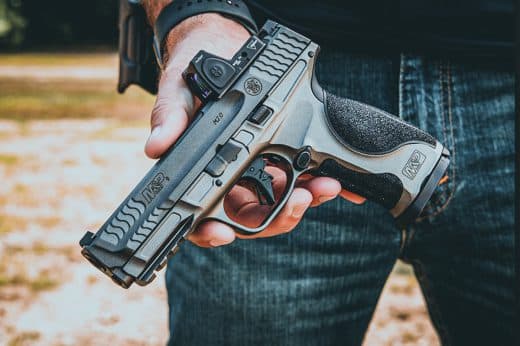
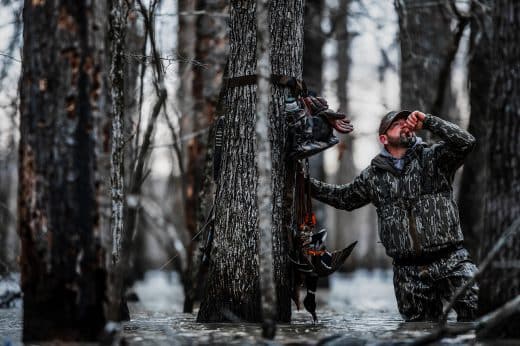
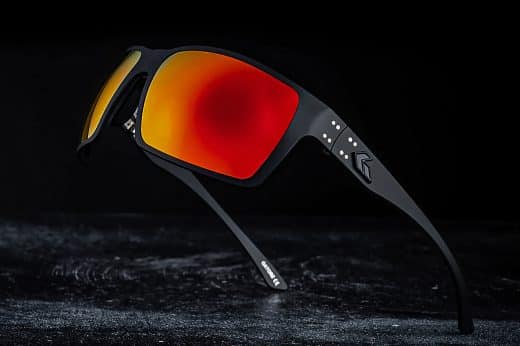


Charles Molnar says
Can’t have a brace on your AR-Pistol, but our government can just “Abandon” 28 billion dollars worth of military equipment, only for it to end up in the hands of a terrorist organization?
bob johnson says
WTF are you talking about, The article is about pistol braces not about military equipment. trump negotiated the pullout. Drain the swap and move in the trailer park.